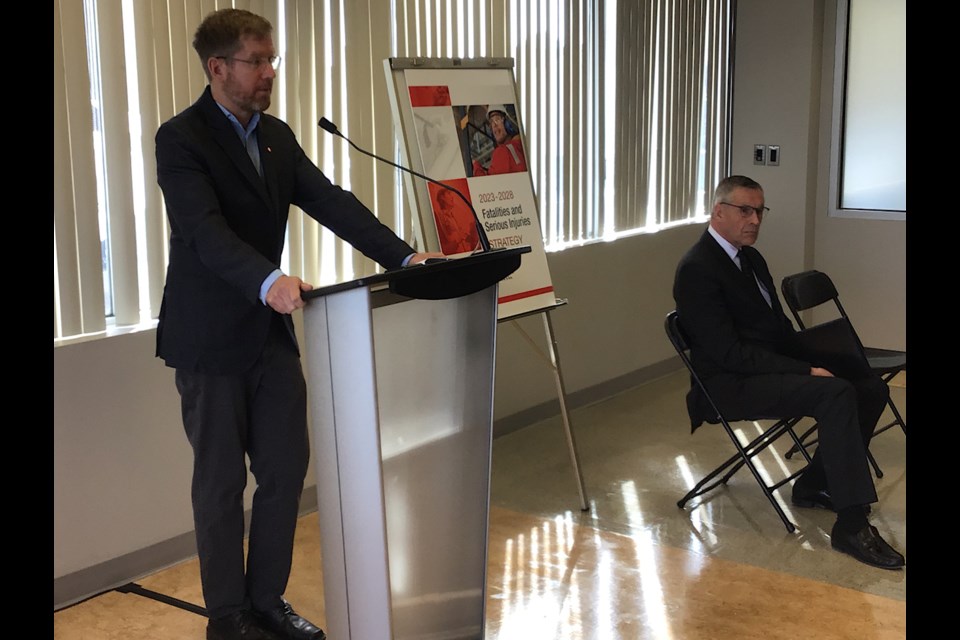REGINA - WorkSafe Saskatchewan has released a new five year strategy on Monday, as they step up efforts to eliminate injuries and fatalities in the workplace.
The announcement of the 2023-28 Fatalities and Serious Injuries Strategy was made by WorkSafe Saskatchewan, which is a partnership of the Saskatchewan Workers' Compensation Board and the Ministry of Labour Relations and Workplace Safety, at a news conference in Regina Monday. The strategy outlined a plan to work towards Mission Zero — achieving zero workplace injuries in the province. Morgan said this required “true commitment from all workers and workplaces in the province, but also from those who play a regulatory and enforcement role in the province. WorkSafe Saskatchewan estimates around 2,400 Saskatchewan workers are seriously injured each year.
The new strategy unveiled Monday follows up on the first three year strategy that was launched in 2019 and ran to 2022.
Labour Relations and Workplace Safety Minister Don Morgan said the new strategy is a continuation of a lot of the things in the previous strategy, but “this will focus on the areas that we knew we had the highest injury rate.”
It focuses on two key streams of work - a regulatory and enforcement stream, and a prevention and learning stream. The three main workplace sectors 小蓝视频 prioritized are health care, transportation, and construction.
These industries were chosen, said Morgan, due to the types of serious injuries happening and also because of their commitment to keep their employees safe.
According to the strategy document, from 2010 to 2021 health care and transportation were the top two industries with serious injuries, accounting for 29 percent of all serious injuries in the province.
In speaking to reporters Morgan said that in the transportation industry many of the main injuries come from motor vehicle accidents, while in health care the main ones are slips, falls, and strains from heavy lifting. Morgan added that in the construction industry, falls from heights are a concern.
As well, the strategy document noted that asbestos was also a major issue, with 40 per cent fatalities from occupational diseases in all industries between 2010-21.
“Unfortunately, we are still seeing far too many people suffering from workplace injuries and tragically, we continue to see too many families struggling with a loss of a loved one due to a workplace fatality,” said Morgan. He said during the first three year term, the province had seen an injury rate reduction from 4.95 per cent to 4.56 per cent — “not nearly enough.”
Five pillar approach
The new strategy outlines a five-pillar approach of awareness, education, targeting/consulting, partnerships and enforcement.
Morgan told reporters the previous strategy focused on inspections, which they want to continue with.
Here, they want to “focus as well on education, training, making workers aware of what their rights are and doing everything we need to do on the enforcement or prosecution side.”
Morgan said as part of the strategy, WorkSafe Saskatchewan will reach out to employers in each of the priority sectors and begin working to improve the health and safety of their organizations.
He said on the enforcement and compliance side the Ministry of Labour Relations and Workplace Safety will be providing ongoing education and legislation to improve compliance, and set a frequency for inspections.
On the enforcement side, Morgan said that as a province they have increased the amount of fines and penalties and had added additional resources to the prosecution side. He said they also added training for the occupational health workers, so they are able to gather evidence so they can get a successful prosecution.
“I think people should know that employers are taking it seriously,as well as the people in this ministry and I thank them for the work that they do.”
New focus on psychological injuries and mental health
A notable new focus in the strategy is on psychological and mental health injuries. The strategy document notes that mental health claims continue to grow with 1,257 psychological injury claims accepted by the WCB between 2017-21. The number of accepted claims had also gone up from 174 in 2017 to 238 in 2021.
Emerging issues, according to the strategy document, include COVID-19, mental health, workload and burnout.
Dr. Sean Tucker, professor of occupational health and safety at the University of Regina, had been involved in the consultation process to put the strategy together. He told reporters there was “strong agreement” more action was needed to address the number of fatalities.
It brings “visibility and awareness to the problem and also focuses on some of the sectors with high rates.” The next step is to collaborate on a roadmap to address injuries in these sectors.
Tucker also was asked about the new focus on psychological injuries. He noted the Workers Compensation Board over the years have seen their policies evolve in terms of adjudicating psychological injury claims.
“With those policy changes, we’re having more of those injuries accepted now and reflected in claims,” said Tucker. He also noted there’s a cost associated with workers suffering psychological injuries, and to employers who are seeing their premiums go up.
“We need to take that energy that we dedicate to preventing physical injuries and focus on psychological injuries as well.”
Phillip Germain, CEO of Saskatchewan Workers Compensation Board, said they had been accepting psychological claims since the 1970s. But they started to see a rise in 2016 when the government changed the legislation to make it easier for injured workers to report psychological injuries.
“There’s been a steady increase, it’s starting to level off, but it’s all up from the pre-2016 legislation change,” said Germain. He noted people were reporting more, and because of that even their acceptance rate was up as well.





